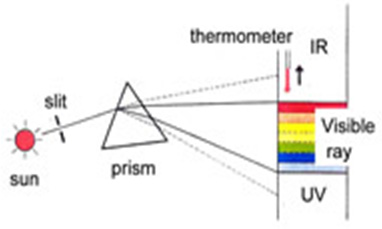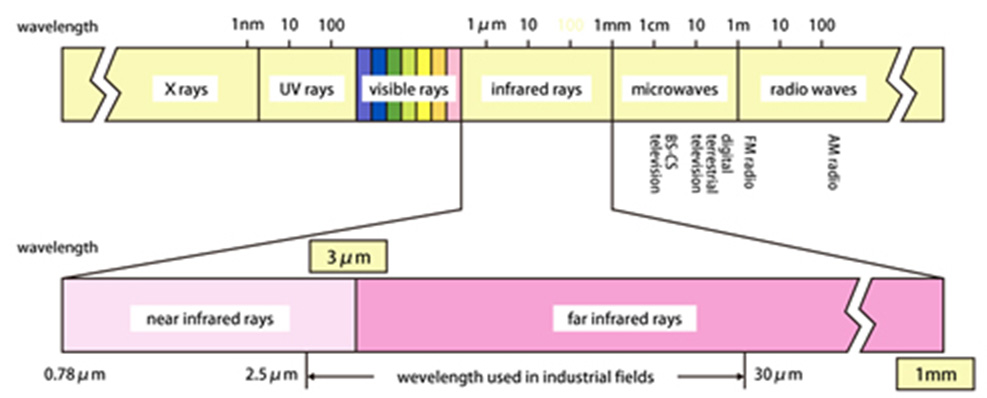ABOUT FIR
(1) Discovery of infrared rays
Everybody knows that it becomes warm by solar light.
English astronomical scholar, Herschel discovered that there is the part that can warm the things in the solar light. In 1800, when Herschel experimented that solar light shoots to the prism, he discovered the existent of invisible infrared rays by raising the indicated value of the thermometer which is placed outside of red in 7 colors visible light.

Fig.1 Schematic view of Herschel’s experiment
(2) far infrared rays in the infrared rays
The invisible light with the power to warm the things was named “infrared rays”, because they exist outside of red in visible light as shown in Fig.1.
The infrared rays are the kind of electromagnetic waves, as well X ray, UV, visible light, microwave and radio waves. The electromagnetic waves have the name depending wavelength shown in Fig.2. They also have the characteristics depending wavelength.
The Infrared rays are divided into two wavelength regions, “near infrared rays” and "far infrared rays". The electromagnetic waves with the wavelength from 3μm (micron) to 1mm (millimeter) = 1,000 microns are defined as the far infrared rays by JIRA (Japan Far Infrared Rays Association). It is the reason that the electromagnetic waves more than 3μm in wavelength just match the molecule vibrations forming articles surrounding us such as stones, woods, plastics, fibers, waters, foods and animals including a human being.

Fig.2 Position of far Infrared rays in electromagnetic waves
Many materials in our personal belongings except metal (plastics, paints, textiles, wood, rubber, food and so on) absorb the electromagnetic wave from 2.5 μ m to 30 μm in wavelength (mainly in the far infrared region) well. The far infrared rays with above wavelength are mainly generated from heated ceramics. It is the reason that the far infrared ceramics heater is widely used as a heat source of heating and drying in industrial and commercial fields.
The oxygen and nitrogen in air do not absorb far infrared rays, however, carbon dioxide (CO2) and water vapor (H2O) absorb far infrared rays well.
(3) What are the far infrared radiation to?
All meterials more than absolute zero (-273 degrees Celsius) radiate energy of the far infrared region, the higher the temperature, the higher radiation dose (energy) is a lot.
It came to be known that the amount of radiation is affected by a material and the surface condition in the case of same temperature. In various kinds of materials, ceramics radiate a lot of far infrared rays.
The radiation of the far infrared rays is low in metal, however metal reflects it well. Metals are used as a reflector with high reflectance.
In general, the heat moves from the one where the temperature is high to low one by radiation.
(4) Physical Characteristic of FIR
Upon being absorbed by the soft tissues of human body, FIR (4-15microns) appears to be most resonant with cell tissues. This natural process, known as “resonance absorption”, produces warmth and accelerate blood circulation, stimulates metabolism, is vital important to the body's proper functioning. Regular exposure to far infrared rays is similar to physical exercise in its effects on the body.
